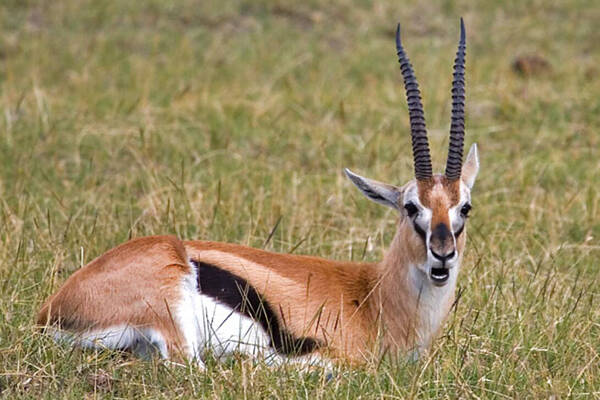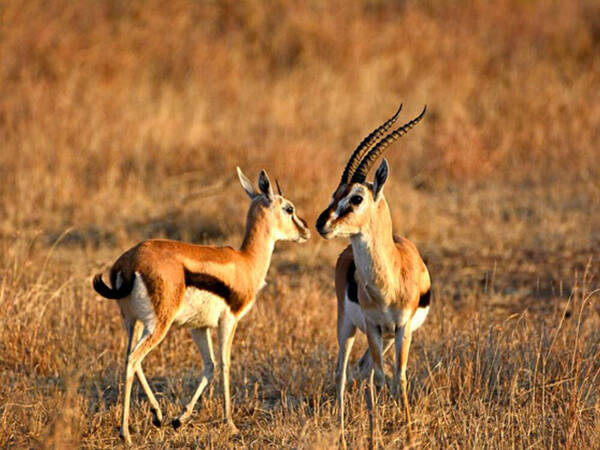Eudorcas rufifrons
IUCN
LCBasic Information
Scientific classification
- name:Eudorcas rufifrons
- Scientific Name:Eudorcas rufifrons
- Outline:Ungulata
- Family:Artiodactyla Bovidae Gazelle
Vital signs
- length:90-110cm
- Weight:25-30cm
- lifetime:About 15 years
Feature
The cheeks have a red center with a pair of white stripes and a black stripe underneath
Distribution and Habitat
The Red-fronted Gazelle is found in Burkina Faso, Cameroon, Central African Republic, Chad, Mali, Mauritania, Niger, Nigeria, Senegal, and Sudan.
Extinct: Ghana.
The Red-fronted Gazelle was once widespread across the grasslands, savannahs, savanna woodlands, and scrublands of the Sahel. The Red-fronted Gazelle is able to adapt to human occupation of its habitat to some extent, for example, it can reoccupy fallow land if adequate cover and hiding places are available. The species is locally present in small to moderate numbers in largely undeveloped rangeland areas. It makes seasonal migrations in parts of its range, although these movements are increasingly restricted by human settlements.
The Red-fronted Gazelle lives in dry grasslands, savannahs, and scrubby sands. It shows a preference for open herbaceous habitats, interspersed with thorny bushes and trees for shade. It avoids densely wooded areas, rising to altitudes of up to 1,400 meters in Ethiopia. The species cannot to
Appearance
Male and female Red-fronted Gazelles are similar in size. The head and body are 90-110 cm long, the shoulder height is 65-70 cm, and the tail is 20-30 cm long; adults weigh 25-30 kg. The coat is generally reddish-brown, except for the underside and rump, which are white. There is a typical narrow black stripe from the elbow to the knee joint (hind legs), which is 2-4 cm wide. A strip of brownish-red hair separates the black stripe from the white base. The tail has a tuft of black hair. The red center of the cheeks has a pair of white stripes extending from the eyes to the corners of the mouth, with a black stripe below. Both sexes have horns with a slight S curve. The female's horns are smooth, slender, straight, and 15-40 cm long; the male's horns are much thicker, deeply ringed, and can be up to 22-40 cm long.
Strong physique; with legs suitable for long-distance running; there are 4 toes on the feet, but the lateral toes are more degenerate than those of deer, which are
Details
Red-fronted Gazelle (scientific name: Eudorcas rufifrons) is also known as Red-fronted Gazelle in English. It has 5 subspecies.

Thomson's gazelle is closely related to the red-fronted gazelle, but is easily distinguished from it by its wide black stripes. The front of the body of the red-fronted gazelle is the same color as the black gazelle, but lacks the black side stripes (red instead), and has more curved horns.
Red-fronted gazelles are not adapted to arid conditions. They feed along the southern edge of the Sahara Desert during the rainy season, but must migrate south to find adequate water during the dry season. Even where they are relatively common, population densities are generally low, at only 0.3-0.7 individuals per square kilometer. When startled, the species emits a series of short "gasping snorts" while squeezing its nostrils forward. Red-fronted gazelles are solitary, in pairs, or in small groups. Occasionally, groups of up to 15 gazelles are seen, but usually no more than 6.
Red-fronted gazelles are herbivorous animals, feeding mainly on grasses, but also eating leaves from trees and shrubs. Predators are mainly carnivores, most of which are large carnivores, including cheetahs, African wild dogs, lions, leopards, and hyenas.

The gestation period of the red-fronted gazelle is 184-189 days, and the lactation period is about 1 month. They breed in the wild most of the year. The young gazelle is a typical "hider" species. After giving birth, the mother will hide the young gazelle in tall grass or bushes and raise and care for them. Females may reach sexual maturity as early as 9 months, while males may not reach maturity until 18 months. Lifespan in captivity is up to 14.5 years.
Although once common, the Red-fronted Gazelle has lost much of its habitat and populations survive only in fragmented locations. As of 2016, the total number of Red-fronted Gazelle was estimated to be approximately 25,000, most of which live outside protected areas. The largest populations are found in Chad, Mali, and Niger. Threats are primarily from hunting, overgrazing by livestock, and clearing of land for agriculture. The population of Red-fronted Gazelle has been reduced to scattered remnant populations throughout much of its range due to illegal hunting, competition with domestic livestock, and habitat degradation caused by drought, overgrazing by livestock, and clearing of land for cultivation.
Approximately 15% of the Red-fronted Gazelle population lives in protected areas (East 1999), particularly in countries such as Niger, Burkina Faso, Benin, Cameroon and Chad (East 1999, Scholte and Hashim 2013). Effective protection and management must be extended to more populations beyond national parks such as Zakouma and Waza. Developing and enforcing land-use plans that allow wildlife outside protected areas in countries such as Chad and Sudan would also have significant benefits for many of the species’ remaining populations (East 1999). Hundreds of Red-fronted Gazelle are captured from the wild and kept with goats, often in cities such as N’Djamena (Scholte and Hashim 2013). Limited numbers of Red-fronted Gazelle are kept in captivity (<25), but there are no formal breeding programs.
Listed in the IUCN Red List of Threatened Species in 2021 - Vulnerable (VU).
Protect wildlife and eliminate game.
Maintaining ecological balance is everyone's responsibility!








